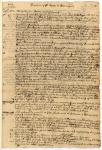
Map of Cape Elizabeth, Richmond Island area, 1884
Maine Historical Society
Text by Richard Judd
Images from Maine Historical Society
Fish was one resource that brought – and kept – Europeans in Maine.
During the 1620s Damariscove supported a year-round population of thirteen fishermen, all employed by Gorges, and served as port for some 30 fishing and fur-trading vessels.

Narrative of voyage to Pemaquid, 1677
Maine Historical Society
At Richmond Island off Cape Elizabeth, Robert Trelawny established a fishing and trading post in 1632, and for the next 10 years his son-in-law John Winter managed around 60 Devonshire fishermen working on three-year contracts, along with several farmers, swineherds, traders, artisans, and women domestics.
Winter found the Indians adept at playing English, Dutch, and French merchants against another, so that the traders, as he said, "under sell another & over throw the tradinge with the Indians altogether." Governing his assortment of adventurers was difficult as well: every man, he complained, was "a law to him selfe," there being neither legal code nor government to which he could appeal. He lived in constant threat of attack, making the price of survival, as Winter put it, "hard work, watchfulness, and courage."
Land-based fishing was a response to a new development in preserving fish that involved sun-drying and periodic applications of salt, as opposed to storing fish in barrels of brine aboard the ships.
Dry-curing took several weeks, but it used less salt, and the cargo could be stored more compactly. The desiccated flesh was durable, even in warm latitudes, and it could be carried easily by moving armies. With processing done on land, fishermen found it convenient to stay in Maine rather than endure the month-long return to Europe.

